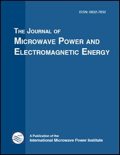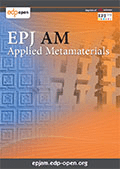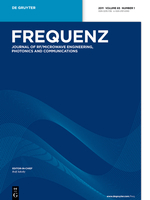
IEEE Letters on Electromagnetic Compatibility Practice and Applications
Scope & Guideline
Empowering Collaboration in EMC Research and Practice.
Introduction
Aims and Scopes
- Electromagnetic Interference (EMI) Mitigation:
The journal covers research focused on strategies and technologies for reducing electromagnetic interference in various systems, particularly in automotive, medical, and communication devices. - Electromagnetic Compatibility Testing:
Studies on methodologies and standards for testing electromagnetic compatibility, including novel test setups and procedures for different environments. - Advanced Material Applications:
Research on the use of new materials such as metamaterials and frequency-selective surfaces in enhancing electromagnetic shielding and absorption. - Modeling and Simulation Techniques:
Development of advanced modeling approaches, including numerical simulations and analytical methods, to predict and analyze electromagnetic behavior in complex systems. - System-Level EMC Solutions:
Focus on holistic approaches to EMC that consider interactions among multiple components and systems, particularly in high-speed and power electronics. - Emerging Technologies and Applications:
Exploration of EMC issues in novel technologies such as electric vehicles, renewable energy systems, and advanced communication technologies.
Trending and Emerging
- Integration of Machine Learning in EMC:
Recent publications increasingly focus on employing machine learning techniques for EMC analysis and predictions, enhancing the ability to manage complex electromagnetic environments. - High-Speed Digital Systems and EMC:
There is a growing emphasis on EMC issues related to high-speed digital interfaces and systems, particularly as data rates increase in communication technologies. - Automotive EMC Challenges:
Research addressing the unique EMC challenges posed by electric and autonomous vehicles is on the rise, highlighting the need for solutions in this rapidly evolving sector. - Innovative EMI Testing Methods:
Emerging methods for EMI testing, including real-time monitoring and augmented reality applications, are gaining traction within the journal's publications. - Flexible and Wearable Electronics:
The journal is seeing increased interest in EMC considerations for flexible and wearable electronic devices, reflecting broader trends in consumer electronics and healthcare.
Declining or Waning
- Low-Frequency EMC Studies:
There has been a noticeable decline in research specifically targeting low-frequency electromagnetic compatibility, possibly due to a shift towards high-frequency applications and digital systems. - Traditional EMC Testing Methods:
Conventional methods for EMC testing are becoming less prevalent as newer, more efficient methods and technologies emerge, leading to a waning interest in older techniques. - Basic EMI Characterization Techniques:
As the field evolves, there is less focus on basic characterization methods, with more emphasis being placed on complex, system-level analyses and advanced modeling. - Static and Passive Shielding Solutions:
Research on static shielding methods is decreasing, potentially due to the rise in dynamic and adaptive shielding solutions that offer improved performance.
Similar Journals

Journal of Electrical Engineering & Technology
Pioneering Insights into Electrical Engineering ProgressJournal of Electrical Engineering & Technology is a prominent academic journal published by SPRINGER SINGAPORE PTE LTD, dedicated to advancing the field of Electrical and Electronic Engineering. With an established history since 2008, the journal has become a vital resource for professionals, researchers, and students seeking to explore innovative research and technological developments within the discipline. The journal boasts a commendable 2023 Scopus Rank of #334 out of 797 in its category, reflecting its quality and the impact of published works. As a Q2 category journal, it upholds rigorous peer-review standards, making it a credible platform for disseminating groundbreaking findings. While currently not an open-access publication, the journal ensures that its content is accessible to a global audience committed to knowledge enhancement and technological progress. Subscribe or access issues through institutional affiliations to stay at the forefront of advancements in electrical engineering.

Journal of Contemporary Physics-Armenian Academy of Sciences
Illuminating the Latest Developments in Physics and Astronomy.Journal of Contemporary Physics-Armenian Academy of Sciences is a distinguished publication dedicated to advancing the field of Physics and Astronomy. Published by PLEIADES PUBLISHING INC, this journal features cutting-edge research that addresses contemporary issues and developments within the realm of physics. With an ISSN of 1068-3372 and an E-ISSN of 1934-9378, the journal enjoys recognition within the academic community, currently holding a Q3 category quartile ranking in 2023, indicating its relevance and contribution to general physics and astronomy. Although the journal is not open access, it provides valuable insights and a platform for scholars and researchers to share their findings, thus promoting collaboration and innovation in the field. Based in the United States, at PLEIADES HOUSE, 7 W 54 ST, NEW YORK, NY 10019, the Journal of Contemporary Physics serves as a vital resource for researchers, professionals, and students aiming to stay informed about the latest scientific advancements and theoretical explorations.

JOURNAL OF MICROWAVE POWER AND ELECTROMAGNETIC ENERGY
Catalyzing Collaboration in Cutting-edge Electromagnetic ResearchThe Journal of Microwave Power and Electromagnetic Energy, published by Taylor & Francis Inc, is a premier scholarly journal dedicated to the advancement of research in the fields of microwave power and electromagnetic energy. With a strong focus on innovative applications and theoretical developments, this journal serves as a vital platform for researchers, professionals, and students alike, fostering collaboration and dissemination of cutting-edge findings since its inception in 1985. Although currently categorized in the Q3 and Q4 quartiles across various disciplines such as Ceramics and Composites, Electrical and Electronic Engineering, and Condensed Matter Physics, the journal consistently emphasizes both experimental and computational methodologies. As part of its commitment to excellence, the journal is indexed in Scopus, boasting a rank of #76 in Metals and Alloys and a percentile standing that reflects its niche yet significant role in the scientific community. While the journal does not offer Open Access options, it remains an essential resource for those invested in the evolving landscape of microwave technology and electromagnetic energy research, with converged years extending through 2024. Researchers are encouraged to contribute impactful articles that can inspire breakthroughs and fuel further inquiries in this dynamic field.

EPJ Applied Metamaterials
Catalyzing Collaboration in the Metamaterials CommunityEPJ Applied Metamaterials, published by EDP SCIENCES S A, is a leading open-access journal dedicated to the dynamic field of metamaterials and their applications in various domains of physics and engineering. Since its inception in 2014, this journal has provided a vital platform for researchers to share innovative findings and advancements, facilitating the widespread dissemination of knowledge in Condensed Matter Physics, Materials Science, and Mechanics of Materials. With an impressive trajectory towards becoming a significant resource for academia and industry alike, EPJ Applied Metamaterials has achieved a commendable Q3 ranking in relevant categories according to the 2023 metrics, indicating its increasing impact within the scientific community. The journal is committed to fostering open dialogue and collaboration through its open-access model, ensuring that all research is freely accessible to a global audience. Scholars, professionals, and students alike are invited to contribute to this evolving field, harnessing the journal as a means to influence both theoretical and applied metamaterial research.

APPLIED COMPUTATIONAL ELECTROMAGNETICS SOCIETY JOURNAL
Connecting theory and practice in the realm of applied electromagnetics.Applied Computational Electromagnetics Society Journal, published by the Applied Computational Electromagnetics Society, serves as a crucial resource for researchers and professionals in the fields of Astronomy and Astrophysics as well as Electrical and Electronic Engineering. With a publication history spanning over three decades, this journal has established itself as a prominent platform for disseminating innovative research and advancements in computational electromagnetics. Offering insights into both theoretical and practical applications, the journal has been categorized in the Q3 and Q4 quartiles in its respective fields for 2023, ranking #61 out of 90 and #557 out of 797 in Scopus' percentile ranks. Researchers and students will find value in its comprehensive exploration of topics, making it essential reading for those engaged in electromagnetic theory, computational methods, and their applications in modern technology. Although not an open-access journal, its contributions remain pivotal in advancing knowledge and fostering collaboration in the electromagnetic community.

Frontiers in Electronics
Exploring New Dimensions in Electronics TechnologyFrontiers in Electronics is a pioneering open-access journal published by FRONTIERS MEDIA SA, dedicated to advancing the field of electronics and its interdisciplinary applications. Established in 2020, this journal serves as a crucial platform for researchers and professionals to disseminate innovative findings and share advancements in areas such as semiconductor technology, nanotechnology, and circuit design. With ongoing commitment to open access, the journal ensures that cutting-edge research is publicly available, enhancing knowledge dissemination and collaboration among the global scientific community. By encouraging submissions that push the boundaries of electronic sciences, Frontiers in Electronics aspires to shape future trends and foster technological innovations, making it an essential resource for students, researchers, and industry experts alike. For further engagement, the journal can be accessed online under the E-ISSN 2673-5857, providing valuable insights to anyone interested in the fast-evolving landscape of electronics.

Progress in Electromagnetics Research Letters
Exploring Breakthroughs in Electronics and MagneticsProgress in Electromagnetics Research Letters, published by EMW PUBLISHING, is a vital peer-reviewed journal dedicated to the fields of electronics, optics, and magnetics. With an emphasis on innovative research and technological advancements, this journal has established itself in the academic community since its inception in 2008, and it will continue to publish valuable findings through 2024. The journal holds a respectable Q3 ranking in Electronic, Optical and Magnetic Materials, positioning it among the noteworthy contributions to the field, despite its percentile standing in Scopus. Researchers and professionals benefit from its commitment to disseminating high-quality research without the constraints of open access, ensuring that cutting-edge ideas reach a targeted audience. By fostering knowledge exchange, Progress in Electromagnetics Research Letters is poised to influence current and future advancements in electromagnetic technologies, making it a trusted platform for scholars and practitioners alike.

Advances in Radio Science
Advancing Knowledge in Electrical EngineeringAdvances in Radio Science, published by COPERNICUS GESELLSCHAFT MBH, is a leading open-access journal established in 2003, dedicated to the rapid dissemination of high-quality research in the field of radio science, particularly focusing on advancements in electrical and electronic engineering. With an ISSN of 1684-9965 and an E-ISSN of 1684-9973, this journal is indexed and provides an avenue for researchers to contribute to the latest developments and innovations within the domain. Despite its current Q4 ranking in the Electrical and Electronic Engineering category, its commitment to open access ensures that all published articles are freely available to a global audience, fostering collaboration and knowledge sharing among engineers, researchers, and students alike. Situated in Göttingen, Germany, the journal continues to evolve and expand its reach, with content converging until 2024, emphasizing its relevance in a rapidly changing technological landscape. Whether you're a seasoned researcher or an emerging scholar, Advances in Radio Science invites you to explore the frontiers of radio science and contribute to its growing body of knowledge.

Radiophysics and Quantum Electronics
Advancing the Frontiers of Radiophysics and Quantum ElectronicsRadiophysics and Quantum Electronics is a leading scholarly journal published by SPRINGER, dedicated to advancing knowledge in the fields of radiophysics and quantum electronics. With a rich publication history dating back to 1967 and covering anticipated insights up to 2024, the journal serves as a crucial resource for researchers engaged in the exploration of areas such as Astronomy and Astrophysics, Electrical and Electronic Engineering, and Nuclear and High Energy Physics. Although it is classified in lower quartiles in several categories, its ongoing commitment to quality research and critical advancements adds invaluable knowledge to the scientific community. The journal does not currently offer open access options, allowing for traditional publication standards that uphold rigor and academic integrity. Researchers, professionals, and students alike can benefit from the comprehensive articles and studies published within its pages, making Radiophysics and Quantum Electronics an essential addition to any academic library focused on the nuances of modern physics and engineering.

FREQUENZ
Elevating Knowledge in Electrical and Electronic TechnologiesFREQUENZ is a prestigious academic journal published by Walter de Gruyter GmbH, focusing on the dynamic field of Electrical and Electronic Engineering. Established in 1949, this journal has a long-standing tradition of disseminating high-quality research and developments within the engineering community. With an ISSN of 0016-1136 and an E-ISSN of 2191-6349, it offers a well-rounded platform for both theoretical and practical advancements in electrical and electronic technologies. The journal is indexed in Scopus, holding a rank of #470 out of 797 in its category, placing it in the 41st percentile, which highlights its relevance and impact within the profession. Although not open access, FREQUENZ remains a vital resource for researchers, professionals, and students seeking to stay abreast of the latest innovations and scholarly discussions in the field. The journal's commitment to quality and its significant contribution to the advancement of knowledge represent invaluable assets in supporting the growth of the engineering community.